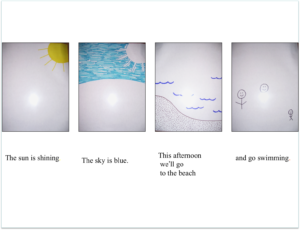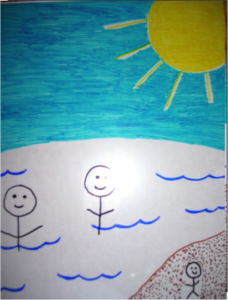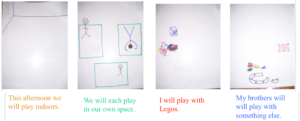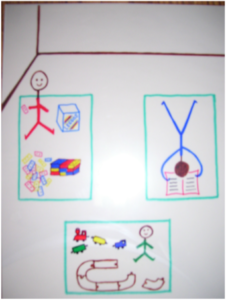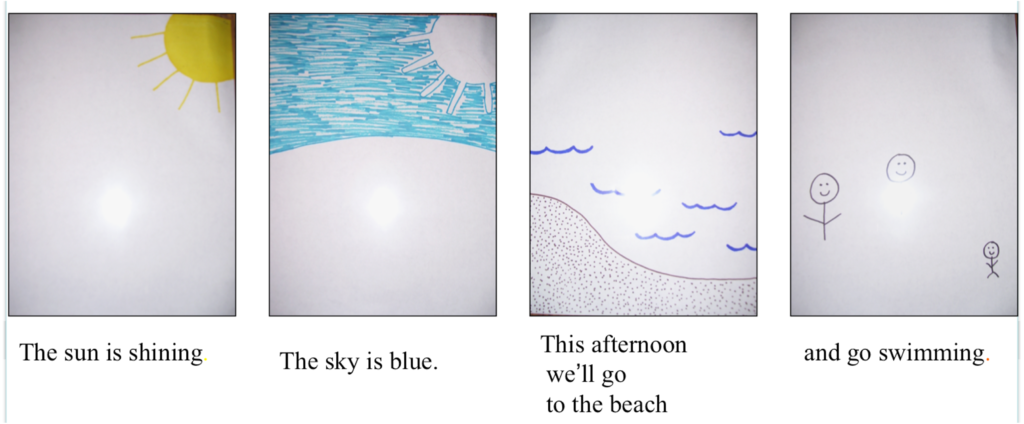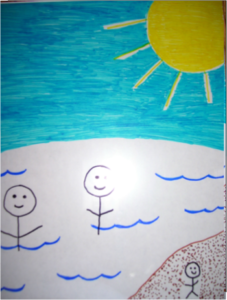This is the third part of a blog series with this outline
Part One: Creating Pictures in Layers With Two Take and Make Visual Examples
Part Two: Changing or Replacing a Layered Picture With One Take and Make Visual Example
Part Three: Creating, Changing and Replacing Pictures Conclusion
In Part One of this blog series the reader was introduced to the autistic friendly method of creating pictures in layers. Visual examples were given. Each layer of the story is created on see through overhead projector sheets. This allows the elements of the story to be stacked up to make one picture. The story elements looked like this:
Stacked together the elements of THE STORY create one picture that looks like this:
In Part Two of this blog series our story continued. It rained and going to the beach was no longer possible, continuing with layered overheads stacked on top of this original story, the UNEXPECTED EVENT story looked like this:
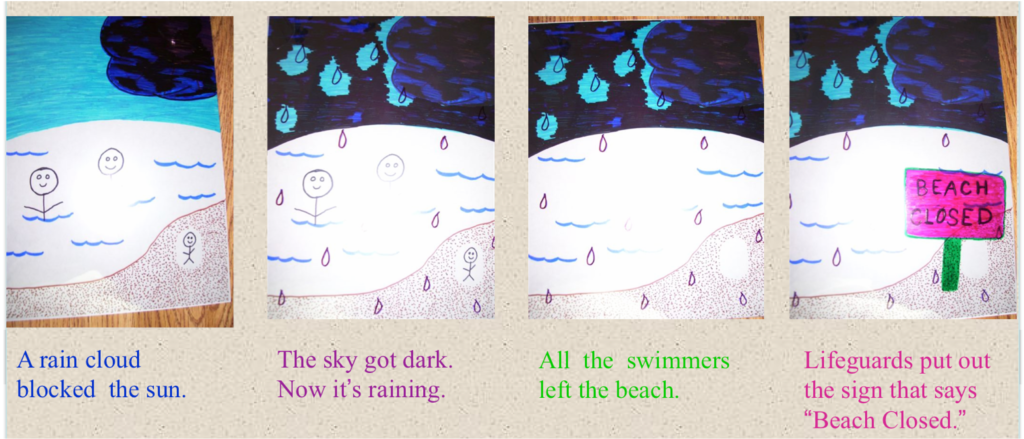
Notice in the third overhead of the above picture of our layered transition story the swimmers left the beach. This is one great reason for the layered pictures! It allows one element of a picture to change without needing to destroy the entire picture. That feeling of “everything changed” is prevented. This often prevents meltdowns.
Next, a TRANSITION STORY was created that allowed the “putting away” of the original story, thus making room for the alternative – the change in plans. There were no new elements added to our existing UNEXPECTED EVENT story. Instead of adding new events the TRANSITION STORY simply solidifies that the ORIGINAL STORY will no longer happen. This allows the autistic neurology to process that there is a change. Notice the picture of the TRANSITION STORY is the same as the ending of the UNEXPECTED EVENT story.
-
-
-
-
- Nobody is at the beach.
The beach is closed. - We won’t go to the beach today.
The beach is closed. - We won’t go swimming.
- The beach is close
- Nobody is at the beach.
-
-
-
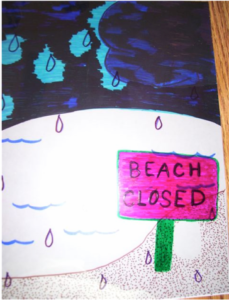
The transition story will need to be repeated until the child is tired of the it and ready to transition to something different. Only then is the child ready for the new activity able to be introduced. Talking about the new activity too soon will hit the neurology as a surprise and may precipitate a meltdown.
And then, when the neurology is ready, the new plans can be introduced such as the story from Part One of this blog series called Playing Indoors.
Creating, Changing and Replacing Pictures Conclusion
Please see Part One and Part Two of this blog series for further discussion of everything mentioned in this blog so far. AND know that any event can be mapped out is similar story fashion than the stories presented. Here is the protocol in words rather than in pictures for those readers who would like them! The protocol is in the top two horizontal rows of this chart. The third horizontal row gives examples/hints for implementation. The last horizontal row tracks the story examples used in this blog series.  Often times when people see this protocol they feel it will take too long. For those who have used it they are surprised that even though it does take some time, it is often considerably less time than the time the child spends in a meltdown and then recovering from the meltdown. Additionally, it is much easier to talk this through (or draw it out for those needing the visual support or for those needing decreased auditory input in the moment) than it is to deal with a meltdown.
Often times when people see this protocol they feel it will take too long. For those who have used it they are surprised that even though it does take some time, it is often considerably less time than the time the child spends in a meltdown and then recovering from the meltdown. Additionally, it is much easier to talk this through (or draw it out for those needing the visual support or for those needing decreased auditory input in the moment) than it is to deal with a meltdown.
~~~~~~~~~~~~~~~~~~~~~~~~~~~~~~~~~~~~~~~~~~~~~~~~~~~~~~~~~~~~~~~~~~~~~~~

If you are a clinician and interested in learning more about therapy with the autistic client please join me along with two of my colleagues in an online course.
CLICK HERE for additional information about Mental Health Therapy with the Autistic Client.
Note: The author is a mental health therapist and is also autistic. She iintentionally uses identity-first language (rather than person-first language), and invites the reader, if interested, to do further research on the preference of most autistic adults to refer to themselves using identity-first language.
This blog series is based on Chapter 9 from Autistically Thriving:Reading Comprehension, Conversational Engagement, and Living a Self-Determined Life Based on Autistic Neurology, pg. 126-133.
BY JUDY ENDOW
Endow, J. (2021). Executive Function Assessment. McFarland, WI: Judy Endow.
Endow, J. (2019). Autistically Thriving: Reading Comprehension, Conversational Engagement, and Living a Self-Determined Life Based on Autistic Neurology. Lancaster, PA: Judy Endow.
Endow, J. (2012). Learning the Hidden Curriculum: The Odyssey of One Autistic Adult. Shawnee Mission, KS: AAPC Publishing.
Endow, J. (2006). Making Lemonade: Hints for Autism’s Helpers. Cambridge, WI: CBR Press.
Endow, J. (2013). Painted Words: Aspects of Autism Translated. Cambridge, WI: CBR Press.
Endow, J. (2009b). Paper Words: Discovering and Living With My Autism. Shawnee Mission, KS: AAPC Publishing.
Endow, J. (2009a). Outsmarting Explosive Behavior: A Visual System of Support and Intervention for Individuals With Autism Spectrum Disorders. Shawnee Mission, KS: AAPC Publishing.
Endow, J. (2010). Practical Solutions for Stabilizing Students With Classic Autism to Be Ready to Learn: Getting to Go. Shawnee Mission, KS: AAPC Publishing.
Myles, B. S., Endow, J., & Mayfield, M. (2013). The Hidden Curriculum of Getting and Keeping a Job: Navigating the Social Landscape of Employment. Shawnee Mission, KS: AAPC Publishing.
